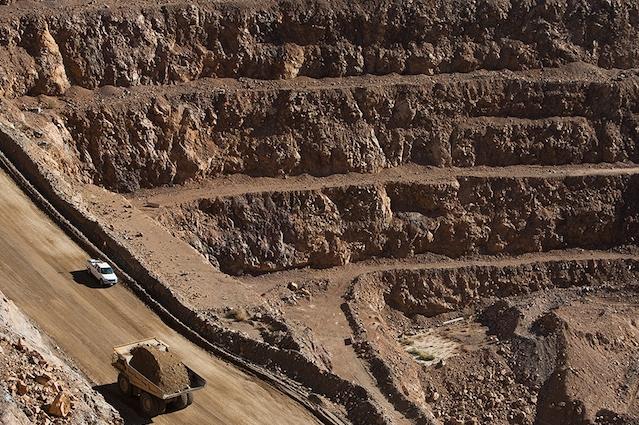
—————-
◆ In the past, extracting and refining rare earth minerals in a cost effective way has been out of reach.
By Greg Johnson
Gillette News Record
Via- Wyoming News Exchange
As flagging coal and oil revenues continue to implode the Wyoming budget by hundreds of millions of dollars, momentum is growing for a more down-to-earth solution.
A push to resurrect the nation’s ability to produce and refine rare earth elements has made some people wonder whether that also could be the phoenix that rises from the ashes of the Powder River Basin’s legacy coal mining industry.
More specifically, from the ash produced by area coal-fired power plants.
Typically a waste product of burning coal to make electricity, coal ash also contains rare earths, which are elements with unique properties that are essential for many technologies like electronics, health care equipment and national defense.
For decades, extracting and refining those elements in a cost-effective way has been out of reach in Wyoming and the United States.
A push in recent years is trying to change that — and a step toward making that happen came this week with the announcement of a $1.62 million, three-year project to put a pilot plant to extract rare earth elements from coal ash in Campbell County.
Part of a larger $30 million federal Department of Energy initiative to develop domestic production and refining of rare earth elements, the local project puts Campbell County at ground zero researching the potential from coal ash, said Campbell County Commissioner Rusty Bell.
“This shows there’s finally a focus on a lot of these things and finally, after all these years, the Department of Energy is putting a footprint down here in Campbell County, where a lot of the country’s Btu’s (energy) come from already,” he said.
Researchers at the National Energy Technology Laboratory have developed technologies and methods to extract rare earth elements from coal ash and will build a pilot-scale production facility at the Advanced Carbon Products Innovation Center, which is under development in Campbell County.
The goal is to demonstrate that producing rare earth elements from coal ash is economically viable, Bell said.
Finding another way to generate money from coal production could be key to extending the mining life of the basin, Bell said. The Powder River Basin coal industry has seen production and profitability nosedive over the past decade and sparked five of its largest producers into bankruptcy.
“We mine better than anybody in the world, so if we’re going to mine rare earths, why not do it here?” he said, adding there’s potential to build another economy around rare earths.
“We need to not only mine them here, we need to process here, manufacture here,” Bell said.
• Bear Lodge and China
That’s just what Rare Element Resources has been working toward since 2011 with its Bear Lodge project, a rare earth elements mine and refining plant in Crook County. The nearly $300 million project includes the Bear Lodge mine south of Hulett about 70 miles from Gillette, and a processing plant to refine the minerals near Upton.
While the project has been on hold since 2016 because an OK from the U.S. Forest Service came too late for Rare Element Resources investors, the company has since found a new partner and is working toward opening the first American rare earths mine in decades, said George Byers, a consultant for the company and longtime mining industry executive.
“Bear Lodge is the real deal,” he said about the potential for producing rare earth elements domestically.
But the key to the project is the processing plant, he said.
That’s because China has a monopoly on rare earths. Even if they’re mined here, it still would have to be shipped to China because the U.S. doesn’t have a way to extract and refine the materials.
China’s chokehold in the world’s production and refining of rare earth elements has prompted a push for the United States to wean itself off its dependence on China for the essential minerals. That push comes from the top with President Donald Trump and top defense officials before him.
A decade ago, China produced as much as 97% of the rare earth elements used in the world. While that has dropped to about 80% now, the United States still gets 99% of its rare earths from other countries.
More importantly, China not only mines and refines the minerals, it also has strong-armed manufacturing to move from the U.S. to China if companies want to buy its rare earth elements, Byers said. Another condition is that companies share their technology with the Chinese government.
“There are a number of reasons we need to (produce) these here,” he said. “What China has done on curtailing production and exports … they’re sort-of forcing companies to move their production of gizmos and cellphones and washing machines and fluorescent lights to China.
“And it’s been going on a long time.”
One example is that General Electric used to manufacture all of its fluorescent lights in the United States, Byers said. Now all GE fluorescent lights are made in China.
A group of six U.S. senators, including Wyoming Republican Sens. Mike Enzi and John Barrasso, sent a letter to Secretary of the Interior David Bernhardt on April 24 urging him to “support the full range of domestic rare earths supply chain development, from extraction through separation and purification into magnets, metals and alloyed forms of rare earths that are critical to our advanced weapons platforms.”
Producing rare earth elements domestically isn’t only an economic issue, it’s a matter of national security, they wrote.
“It is clear that our dependence on China for vital rare earths threatens our U.S. manufacturing and defense industrial base,” the letter says.
• Shift in policy
Rare earth elements are no longer niche materials needed for making specialty products. From national defense to rechargeable batteries and cellphones, they’re in everyday mainstream products.
Weaning the United States off dependence on China and other countries has been a high priority for the Trump administration.
In a Dec. 20, 2017, executive order, the president said the nation is vulnerable to a break in the supply chain for rare earth elements.
“This dependency of the United States on foreign sources creates a strategic vulnerability for both its economy and military to adverse foreign government action,” the order says.
Areas like Bear Lodge have been identified as having high concentrations of rare earths, yet none are producing.
“An increase in private-sector domestic exploration, production, recycling and reprocessing of critical minerals … will reduce our dependence on imports, preserve our leadership in technological innovation, support job creation, improve our national security and balance of trade and enhance the technological superiority and readiness of our armed forces,” the order says.
National defense is the largest consumer of rare earth elements. One Virginia-class nuclear submarine has 9,200 pounds of rare earth elements in it. The F-35 Joint Strike Fighter jet has 920 pounds of them. The Department of Defense has plans to acquire nearly 2,500 of the fighters at an estimated cost of about $400 billion.
Just mining the minerals isn’t enough, according to a June 2019 federal report titled “Strategy to Ensure Secure and Reliable Supplies of Critical Materials.” The strategy outlines six things that need to happen.
Research: Assesses progress toward developing critical minerals recycling and reprocessing technologies, technological alternatives to critical minerals, source diversification and improving processes for critical mineral extraction, separation, purification and alloying.
Supply chain: Discusses ways to improve critical mineral supply chains, which could help reduce risks to U.S. supply by increasing domestic critical mineral resource development, building robust downstream manufacturing capabilities, and ensuring sufficient productive capacity.
Trade: Identify options for accessing and developing critical minerals through investment and trade with America’s allies and address adverse impacts of market-distorting foreign trade conduct.
Publicize: Get the word out about the importance of rare earth elements and that the United States produce and refine them.
Access: Streamline permitting and review processes related to developing mining claims or leases and enhancing access to domestic critical mineral resources.
Workforce: Address the skills and education needed to build and maintain a robust domestic industrial base.
The scope of America’s reliance on China for these minerals is sometimes hard for people to grasp, Byers said. A basic pickup has about 70 places that have rare earths, from automatic door locks to airbags to fuel injectors and other sensors.
As the COVID-19 pandemic has progressed, he said there’s also been a new awareness of how much the U.S. also is dependent on China for medial equipment.
“We get so much of our medical equipment from China,” he said, which is because of the rare earth elements involved in making it. “India and China produce a huge fraction of the pharmaceuticals we use. Finally, people are realizing, ‘Holy cow, we’re dependent upon them for our medical stuff.’”
• An idea ‘before its time’
Something that may have held up the Bear Lodge project as much as the federal regulatory process is timing, said Rob Godby, an energy economist with the University of Wyoming’s Center for Energy Economics and Public Policy.
“In some ways, it’s come before its time,” he said. “It anticipated a shortage of rare earth elements and, as I understand it, demand is expected to explode and there’s limited supply.
“So, the thought was let’s get in ahead of (providing) a reasonable source of them. That still may happen. Right now, it would be nice to have a new source of domestic activity,” Godby said. “But Wyoming’s perspective is we’ve been a commodities supplier for all our existence. We need value-added products.”
That’s what Bell said Campbell County is counting on. Along with the testing on coal ash announced this week, Rare Element Resources also is in the process of planning a demonstration plant, Byers said.
After a successful test plant overseas with partner General Atomics — in which General Atomics improved the process — they want to build a larger demonstration plant to show how the company’s proprietary refining process scales, he said.
It’s an “intermediate step” before building a plant in Upton and will take about $40 million, money the company is trying to raise, Byers said.
While the potential is considered, it’s also important to know that there’s a reason the United States and just about every other country except China stopped mining and refining rare earths, Godby said.
“The first thing about rare earth elements is they’re not that rare,” he said. “What makes them rare is that there’s not a ton of them on the market.”
Just as nobody wants a landfill next to their home, they also don’t want to be near rare earth processing, Godby said.
“They’re really dirty to process, so to refine them and make them into stuff we want to use, you have to employ refining processes that are pretty messy,” he said.
Because of that, it became “a lot cheaper” for the United States to outsource rare earths, he said.
Environmental regulations made costs in the U.S. “prohibitively expensive” in the past, Godby said. “Also, you don’t want a refinery near you or your watershed. For that reason … you’re going to incur a lot more costs to avoid (becoming) a Superfund site.”
• A rare opportunity
Coal ash isn’t the only potential source of rare earth elements from mining in the PRB, Bell said. The clays that settle above and below coal seams also have rare earths in them.
If it can be done economically, the mines could be potential customers for the Rare Element Resources refinery near Upton when it’s built.
The minerals found in those clays are “going to be low-grade,” Byers said. “But it’s probably going to be higher than what’s in the coal ash.
“So, yes, if you guys can come up with a process that can maybe squeeze some rare earths from the clays or ash, then maybe we can find a way to design another circuit in the plant to take the feed from the coal mines and produce rare earths.”
Byers said he sees no reason why that couldn’t happen, and that being so close to the PRB and an experienced mining workforce is a plus.
“The skills exist and they’re right there,” he said.
The refinery, on the other hand, would help attract and keep educated professionals and scientists in the state as well as create another high-paying industry.
“What’s really exciting is we can put some of these smart kids to work here in Wyoming,” Byers said. “The potential is for a very small mine and a small-but-unique in the Western Hemisphere metallurgy plant to produce a lot more jobs than the mine and the plant put together is enormous.”
Despite more federal hurdles for refining rare earth elements in the United States, it’s imperative we find a way to make it happen, Bell said. And it makes sense to happen here.
“Whether that processing facility is 30 or 40 miles away from us or it’s here in Campbell County, it’s important for our region and the whole state,” he said.
Or, as famed literary sleuth Sherlock Holmes might say, it’s elementary.






